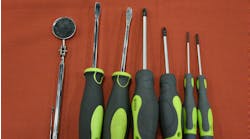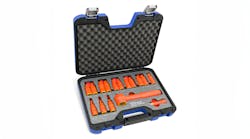Truck-mounted hydraulic systems are crucial to many vocational operations. As with any integral vehicle system, effective maintenance of truck-mounted hydraulic systems requires an understanding of how a system functions.
A basic hydraulic system consists of the following components:
- Power source (engine and transmission)
- PTO
- Pump
- Directional control valve
- Actuators (cylinder or motor)
The PTO, or power take-off, transfers engine power from the transmission to the pump. The pump sends hydraulic fluid to the directional control valve. The control valve sends that fluid to the actuator, which operates the equipment.
Truck-mounted hydraulic systems must be properly spec’d and integrated with the truck’s engine, transmission and PTO. This will ensure that the equipment has the necessary hydraulic flow and pressure to operate correctly and most efficiently.
The most common truck-mounted equipment is the dump truck. Other applications include tow trucks, bucket trucks, cranes, garbage trucks, sewage vacuum trucks, tire service trucks and fire and rescue trucks. While some types of truck-mounted equipment, such as a snowplow, utilize a motor as the actuator, it's more common to utilize a cylinder.
PTO selection and installation
"The PTO is the link between the power source and the driven (operating truck-mounted) equipment," says Jeff King, Chelsea Products marketing manager. "The PTO has to make everything work together."
Chelsea Products, a division of Parker Hannifin, is a market leader in PTO products for the truck and mobile vocational markets.
When selecting a PTO, identify the make and model of the transmission.
"Make sure the gear teeth on the PTO can properly mesh with the transmission's PTO drive gear teeth," King says. For instance, a spur gear will not mesh properly with a helical gear. Even two helical gears need compatible characteristics.
"Additionally, every transmission has unique operating characteristics such as speed," King adds. "Ensure that the PTO has the necessary torque capacity and operating speed for the application."
On that note, you must identify the needs of the truck-mounted equipment itself.
"You need to know the required system pressure (psi) and flow (gpm)," King says. When equipment operates slowly, there is a flow problem. When it won't operate at all, there's a pressure problem.
Ensure that both engine rpm (pump input) and hydraulic pump rpm (pump output) will achieve the necessary flow rate.
"For instance, you want a roughly 30-second cycle time on a dump body, though you should always consult the manufacturer's recommendation," King points out. "Once confirmed, you need to specify the flow requirement (gpm), because flow affects speed of operation."
Flow requirement can then be related back to horsepower and torque. A useful equation to know is: gpm x psi / 1,714 = required hydraulic horsepower. This data will help you select the right size PTO.
It's also helpful to understand PTO installation. The first step is mating the PTO to the transmission.
On a manual transmission, you typically have to set the backlash, which is the spacing between the transmission gears and PTO gears. Use gaskets to shim it to the proper backlash, which is a range of 0.006" to 0.012".
On automatic transmissions, there's far less hassle. A single gasket is typically supplied that takes the guesswork out of setting the backlash.
A second important step is adequately fastening the PTO to the transmission.
"Truck manufacturers don't make it easy to get to all the bolts," King says. "So we worked with Snap-on to develop a set of tools to make it easier and speed up the process." (See sidebar, Recommended Tools for PTO Installation.)
PTO preventive maintenance
Whether or not you installed the PTO, it's a good idea to check the bolts and fasteners a couple of weeks after installation.
"The biggest thing is checking for leaks," says Josh Reimer, market specialist for the dump and tow markets at Muncie Power Products. "If you see signs of either a hydraulic or transmission leak, that's an indication that something is probably loose." You simply want to make sure everything is torqued down properly.
Muncie Power Products is a leading manufacturer of power take-offs and fluid power components for the work truck industry.
Once put into service, the cycle of PTO maintenance will vary by application. A dump truck, for example, might run five to 10 cycles per day. That places less wear on the PTO.
"In that case, you want to visually inspect the PTO for leaks every three months or so," Parker Hannifin’s King says. "Make sure all seals are intact. Check for loose fasteners.
"The other extreme is the refuse (garbage) industry," King continues. "These trucks run many cycles a day, day after day. You'll want to do a thorough inspection every month."
In many instances, the hydraulic pump can be mounted directly to the PTO. "We recommend doing that because it gives the best connection," King says.
Additionally, Parker Hannifin recommends a mounting bracket for pumps longer than 18” or heavier than 40 lbs.
Even with a clean, direct connection, you do have a mating spline between the pump and PTO. This warrants additional maintenance considerations.
"If you don't maintain proper lubrication at this critical juncture, you'll get what's known as fretting," Reimer explains. "The metals wear against each other. That causes small particles to emerge and become captured in that area, making the problem worse and preventing the gear teeth from meshing properly."
"Proper lubrication also helps stop the oxidation and torsionals from the diesel engine from spreading corrosion on those shafts," King says. "However, many technicians don't like performing the ongoing maintenance once the PTO and pump are mated; they don't want to have to take them apart in order to relubricate. So Parker Hannifin has come up with a couple of options."
On a manualtransmission, Parker provides a greaseable option. The PTO shaft has a Zerk fitting on a closed-end bearing cap. On an Allison automatic transmission, Parker offers a wet spline option. Pressurized fluid from the transmission is drawn up to the cavity between the PTO and pump, providing continuous lubrication.
In those instances when you don't have the clearance to mount the pump directly to the PTO, you'll have a driveshaft in between. Make sure it is properly lubricated at the joints.
"You also want to regularly inspect the driveshaft for damage," King says. "If it's bent, you'll sometimes feel a vibration when the PTO is engaged. That's a problem that should be addressed immediately. It's not only detrimental to the PTO output shaft, but also the pump because that vibration is felt by the pump's input shaft, bearings and seals."
Another warning sign is noise. If the PTO has been installed too tightly, or if the gaskets become soaked with oil and compress, you might begin hearing a whine. That means the PTO gear tips and transmission gear tips are too tightly meshed. A gasket needs to be added between the PTO and transmission to get it shimmed to the proper backlash between 0.006" and 0.012".
"You may also begin hearing a clattering noise at some point," King says. "That likely means some bolts are loosening. Go down and check the fasteners. Make sure everything is torqued properly and that nothing is coming loose."
Pump testing and installation
The next component in the hydraulic system is the pump. A high-performing pump requires good connections, no leaks and ample lubrication. Like with PTOs, it all starts at installation.
Before installing a pump, back off the main relief valve until the spring tension on the adjusting screw is relieved. Next, before connecting any lines to the pump, fill all ports with clean oil to provide initial lubrication.
After connecting the lines and mounting the pump, operate for at least two minutes at no-load and low-rpm. During this break-in period, the pump should not develop an excessive amount of heat. If it runs properly, you can increase speed and pressure to a normal level. Reset the main relief valve to its proper setting while the pump is running at maximum operating engine speed for the truck.
Next check the fluid supply. Ensure that at least one gallon of hydraulic fluid is supplied for each gpm of pump capacity. Jog the pump by repeatedly starting and stopping the engine to gradually equalize pump and oil temperatures; feeding hot oil into a cold pump can cause the pump to seize.
Run the pump for at least two more minutes at no-load and moderate speed (less than 1,500 rpm). If the pump becomes excessively hot, shut down the test and locate the source of the problem. Gradually increase the pressure on the pump in 500-psi increments until the desired test pressure has been reached.
Insights on hydraulic oils
Hydraulic systems on truck-mounted equipment often work under extreme temperature changes. Thus, when choosing hydraulic oil, duty cycle and oil temperature must be factored in.
"Under normal operating temperatures, you should keep hydraulic fluid temperature in the 120 to 140 degrees F range," says Chris Johnson, Parker Hannifin's gear pump division. "Operating temperatures over 176 degrees F can dramatically reduce service life."
Viscosity is a key consideration. The hydraulic fluid must be thin enough to flow easily, but also thick enough to seal and maintain a lubricating film between bearing and sealing surfaces. That film helps reduce friction and heat.
Remember that as fluid warms, it becomes thinner. Thus, you must consider your equipment's start-up and operating temperatures.
At the highest temperatures, the fluid must maintain enough thickness to provide lubrication and minimize internal leakage. If it doesn't, the result could be heat-caused loss of lubrication, premature wear and failure of the gears, thrust plates and bearings.
On the other hand, as fluid cools, viscosity increases. At the lowest temperatures, the fluid must still be thin enough to flow readily. If it isn't, sealing and lubrication gaps might not get filled, resulting in damage to the pump.
As a general rule, high-viscosity oil will provide better performance. Oil with a viscosity of around 100 SUS (20 cSt) is ideal in normal conditions. In cold-weather environments, oil should have a viscosity not exceeding 7,500 SUS (1,620 cSt) at the minimum startup temperature, and a pour point of at least 20 degrees F below that temperature. Startup procedures must allow for a gradual warm-up, and equipment should not be operated at full pressure until the oil reaches a reasonably fluid state.
Care should be taken when filling the reservoir with oil. Always pour through a 100 mesh screen.
The reservoir should have a breather to allow air in and out. The filler cap and breather should be sealed to prevent moisture from entering. Even the smallest water content can result in hydraulic component damage.
Observation of a leak around the pump could indicate several things.
"First, the hose and fittings could have worked loose," Muncie Power Products’ Reimer says. "So you want to check that and tighten anything up."
Visual observation for leaks can happen as you conduct routine truck inspections every 100 hours or so, Reimer advises. That's also a good time to check the hydraulic oil level in the reservoir. If you ever see that oil is not flowing from the pump, it could simply be that the oil level is low.
"It could also be airlock in the inlet hose," Reimer says. If it's an airlock, you should use compressed air to pressurize the reservoir while running the pump."
Oil and filters should be changed on a regular schedule and the system flushed in accordance with manufacturer recommendations. Likewise, reservoir air breather filters should be cleaned periodically.
Ensuring optimum cylinder performance
The pump sends hydraulic fluid to a direction control valve, which then directs it to the actuator to engage the equipment. A telescoping cylinder is often the actuator. Fleet managers can take certain steps to ensure proper long-term performance.
Each morning, test cylinder function. Ensure that the cylinder is not leaking fluid, is extending and retracting appropriately and is not coming into contact with any other vehicle component during normal operation.
On a weekly basis, it's a good idea to bleed air from a single-acting telescopic cylinder. "This helps ensure smooth operation," says Mike Sell, product manager – cylinder division, Parker Hannifin. "Failure to do so will likely result in early cylinder failure. To eliminate this risk, we design our telescopic cylinders with a feature that eliminates the air-bleeding procedure by allowing air to bleed every time the dump bed goes up and down."
Because the hydraulic oil in the circuit lubricates virtually all cylinder parts, it's important to keep the oil circuit clean. If there ever is a failure and there is reason to believe that metal particles may be in the system, the oil must be drained, the system flushed and any filter screens thoroughly cleaned or replaced. New oil should then be supplied for the entire system.
Other common causes of cylinder failure include:
- Wear of compression set resulting from a loss of interference or squeeze
- Seal shrinkage after installation (often chemical-induced)
- Debris lodged under seal lip
- Scored seal lip due to sharp particle lodging beneath
- Torn seal lip (more dramatic leakage results)
- Bearing failure
- Spiral failure
- Reverse-pressure blowout of piston seal due to pressure trap or failure of opposed seal.
In conclusion, recognize that no hydraulic system is 100 percent efficient because no single component is 100 percent efficient. However, by following proper installation and preventive maintenance steps, you can help your system function as efficiently as possible - and that can have a huge impact on system life and performance.




